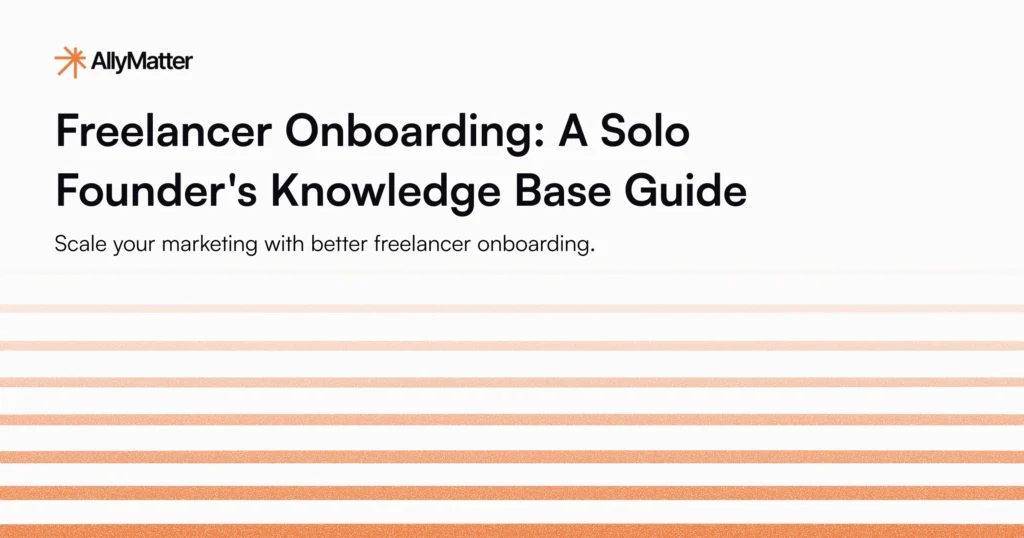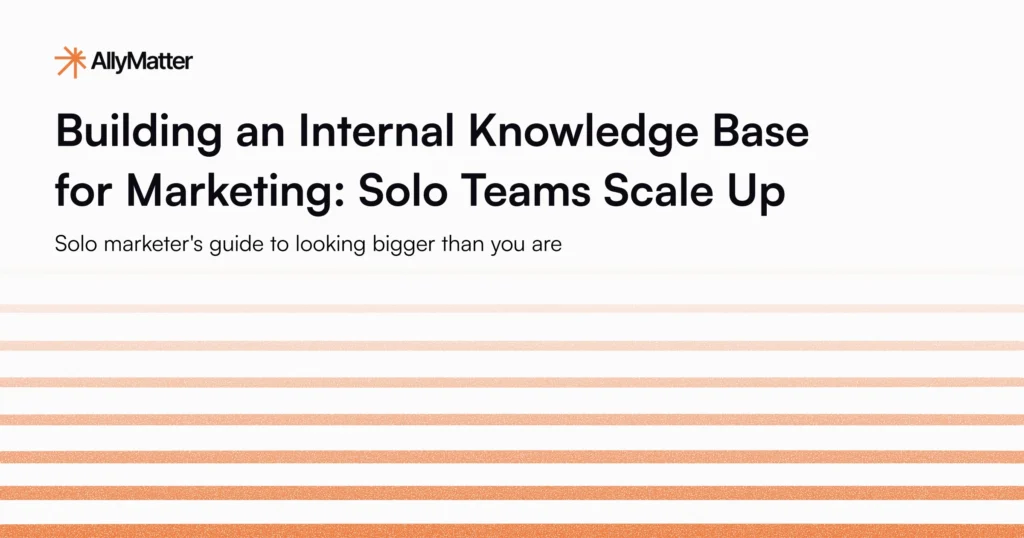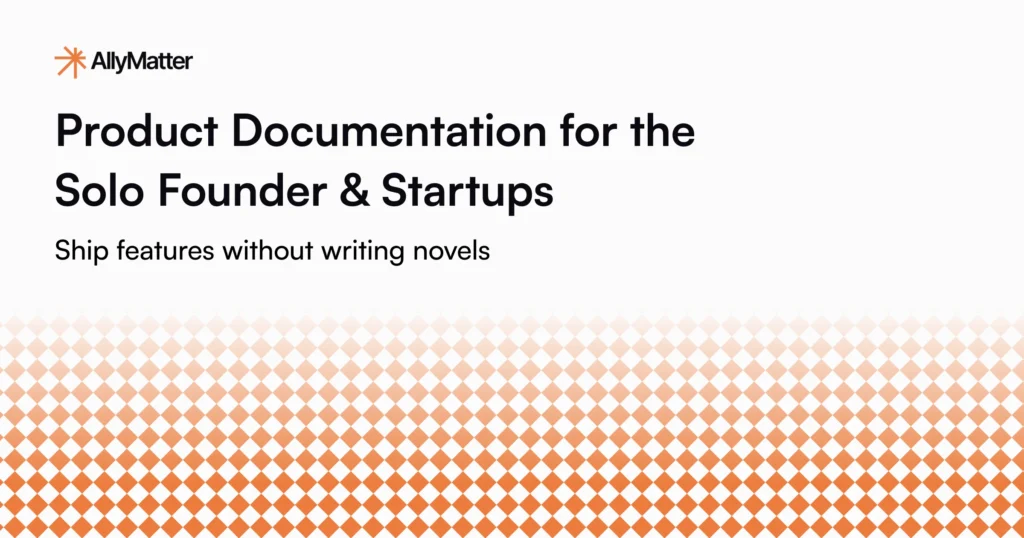Monday morning. Your new engineer joins today. You’re in back-to-back customer calls, your CTO is heads-down fixing a production issue, and the person who usually handles laptop setup is out sick.
By Wednesday, this new hire should be committing code. Instead, they’re still waiting for access to GitHub, don’t know your coding standards, and have messaged five different people trying to figure out your deployment process. They’re frustrated, you’re overwhelmed, and that excitement they had on day one? It’s fading fast.
This scenario repeats at startups everywhere. You hire great people, then waste their first week – sometimes their first month – because onboarding is a chaotic scramble of forgotten passwords, missing context, and “let me find someone who knows that.”
Here’s the thing: Your new hires don’t need hand-holding. They need a clear path. A self-service onboarding system that gets them from zero to productive without requiring heroic efforts from your already stretched team.
The true cost of broken onboarding
Bad onboarding doesn’t just waste time. It actively damages your startup’s ability to scale.
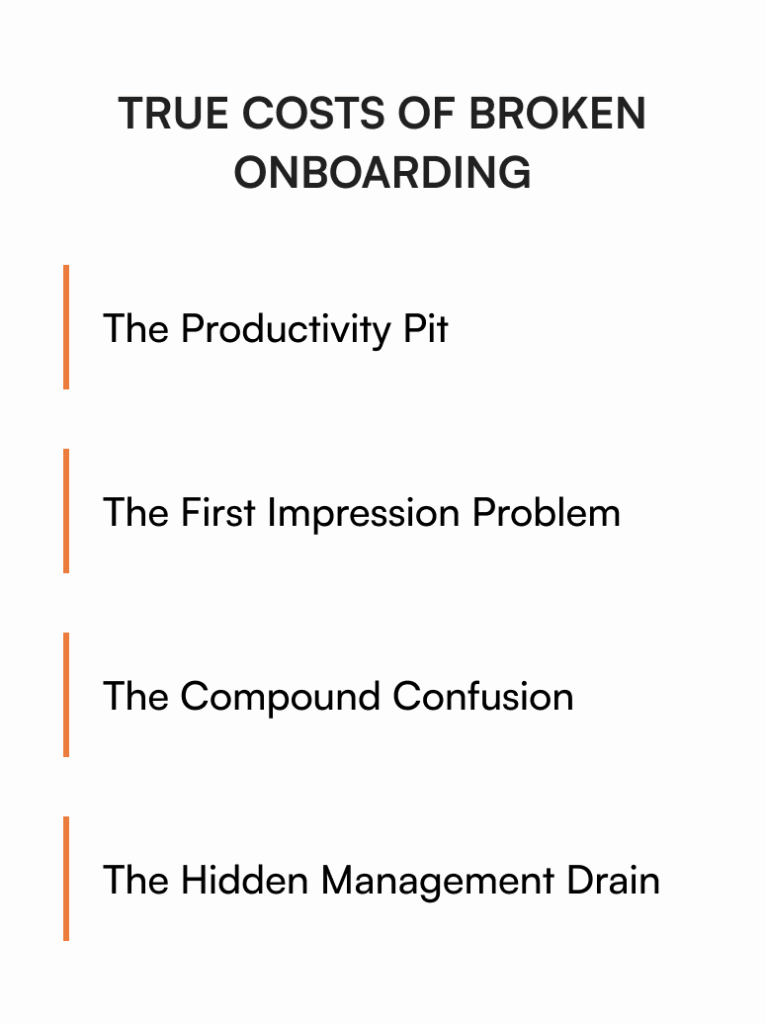
The productivity pit
According to research from the Society for Human Resource Management, it takes new hires an average of 8-12 months to achieve full productivity in professional roles. In startups, you don’t have 8 months. Every week of confusion is a week of burned runway and missed opportunities.
The first impression problem
That talented developer you fought to hire? They’re spending their first week wondering if joining was a mistake. When day three involves sitting idle waiting for access, they’re already updating their LinkedIn to “open to opportunities.”
The compound confusion
Each poorly onboarded employee becomes part of the problem. They pass on incomplete information, create workarounds for broken processes, and add to the chaos. Your onboarding debt compounds with each hire.
The hidden management drain
Your team leads spend 20-30% of their time answering basic questions from new hires. That’s time not spent on strategy, not spent on building, not spent on the high-leverage work you need from them.
Why traditional onboarding breaks at startup speed
Corporate onboarding doesn’t work for startups, but neither does no process at all. Here’s why most approaches fail:
The “buddy system” breakdown
Pairing new hires with experienced employees sounds great until that buddy has their own deadlines. Knowledge transfer becomes sporadic, inconsistent, and dependent on one person’s availability.
The information firehose
Some startups overwhelm new hires with everything at once – 47 documents to read, 12 tools to learn, 5 team cultures to absorb. Without structure and pacing, retention plummets.
The “figure it out” philosophy
Startups pride themselves on hiring smart, autonomous people. But there’s a difference between being resourceful and wasting time reverse-engineering processes that should be documented.
The moving target problem
Your startup changes weekly. The onboarding process that worked last month might be outdated today. Static checklists become lies quickly, creating more confusion than clarity.

The three-day transformation framework
Three days of productivity isn’t about rushing. It’s about focus. Here’s what each day should accomplish:
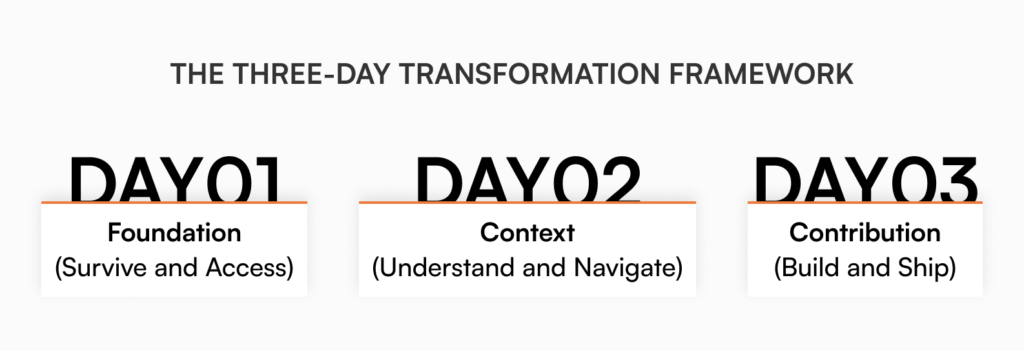
Day 1: Foundation (survive and access)
Goal: Remove all blockers to basic work
Morning:
- Laptop configured with standard tools
- All account access granted and verified
- Communication tools (Slack, email) working
- Physical or virtual workspace ready
Afternoon:
- Meet immediate team (15-minute intros)
- Understand this week’s priorities
- Complete compliance basics (paperwork, security)
- End with one small, achievable task
The key: They should leave day one having actually done something, even if tiny. Contributing immediately builds momentum.
Day 2: Context (understand and navigate)
Goal: Understand how work happens
Morning:
- Product deep dive (what we build and why)
- Customer context (who uses it, key problems)
- Tech stack overview (architecture, key decisions)
- Current sprint/project status
Afternoon:
- Development workflow walkthrough
- Code review of recent changes
- Shadow someone doing core work
- Set up development environment completely
By end of day two, they should understand not just what to do, but why you do it that way.
Day 3: Contribution (build and ship)
Goal: Make first real contribution
Morning:
- Pick first real task (pre-selected, appropriately sized)
- Pair program or work with guidance available
- Use actual workflow (not training wheels)
- Hit first blockers and resolve them
Afternoon:
- Complete and submit work
- Go through real review process
- Ship something (even internal tool counts)
- Reflect on what worked/didn’t
Shipping something real on day three changes everything. They’re no longer “the new person” – they’re a contributor.
Building your self-service onboarding machine
The three-day framework only works with proper infrastructure. Here’s how to build it:
The pre-arrival checklist
Before day one, automate everything possible:
- Order equipment immediately upon offer acceptance
- Create all accounts using a standard checklist
- Schedule key meetings for first three days
- Assign first week’s tasks and prep managers
Document this process once, use it forever. No more “oh, we forgot to create their email” on Monday morning.
The single source of truth
Create one – yes, one – place where new hires find everything:
- Links to all tools with login instructions
- Current team structure with photos and roles
- Development setup guides (step-by-step)
- FAQ addressing actual new hire questions
This isn’t a 50-page manual. It’s a curated guide to exactly what they need, when they need it.
The progressive disclosure system
Don’t overwhelm on day one. Structure information delivery:
Day 1 docs:
- How to get help
- Tool access guide
- Today’s schedule
- Emergency contacts
Week 1 docs:
- Team processes
- Coding standards
- Meeting rhythms
- Project overviews
Month 1 docs:
- Strategic context
- Historical decisions
- Future roadmap
- Deep architecture
The automated checkpoints
Build in verification without micromanagement:
- End of day 1: Can they access everything?
- End of day 2: Do they understand the core workflow?
- End of day 3: Did they ship something?
- End of week 1: Collect structured feedback
These aren’t tests – they’re safety nets to catch problems early.
The critical documents for self-service success
These five documents eliminate 80% of new hire questions:
The “start here” dashboard
A single page with:
- Your first day schedule
- Links to all tools (with passwords/access notes)
- Who to ask for what
- First week goals
- “If stuck, do this” instructions
Keep it scannable, linkable, and current.
The development environment guide
Step-by-step setup that actually works:
- Required software with version numbers
- Clone and build instructions that are tested
- Common errors and solutions
- Verification steps to confirm success
Include time estimates: “This should take 45 minutes. If it’s been 2 hours, ask for help.”
The “how we work” playbook
Your actual workflows, not theoretical ones:
- How code goes from idea to production
- Review process and standards
- Deploy procedures and rollback plans
- Communication norms and response times
Use screenshots and real examples, not abstract descriptions.
The context collection
Why things are the way they are:
- Product vision and target customer
- Technical decisions and tradeoffs
- Team structure and responsibilities
- Current priorities and anti-priorities
This prevents new hires from relitigating settled decisions.
The first week task list
Pre-selected tasks that:
- Are clearly defined with success criteria
- Require using real tools and processes
- Are meaningful but not critical path
- Build in complexity throughout the week
Include example PRs from other first-week contributions.
Measuring onboarding success
Track these metrics to know if your self-service system works:
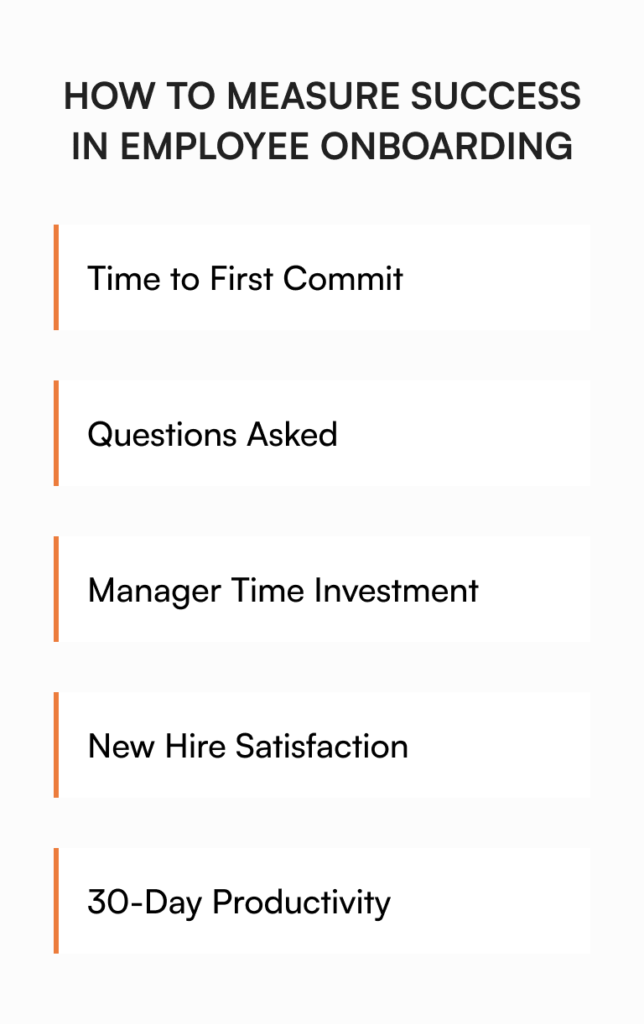
Time to first commit: How quickly do engineers push code? Should be day 2-3, not week 2-3.
Questions asked: Track Slack messages from new hires. Good onboarding reduces repetitive questions dramatically.
Manager time investment: How many hours do managers spend on basic onboarding? Should decrease with better documentation.
New hire satisfaction: Ask specifically about onboarding experience on day 7. They’ll be honest about what worked and what didn’t.
30-day productivity: Are new hires contributing meaningfully within a month? If not, identify the blockers.
Common pitfalls and how to avoid them
Pitfall: Creating documentation then letting it rot
Solution: Assign ownership and update triggers. When processes change, documentation updates the same day.
Pitfall: Making it too startup-specific
Solution: Include glossary of terms, acronyms, and inside jokes. Don’t assume context.
Pitfall: Perfectionism paralysis
Solution: Ship rough documentation, improve based on new hire feedback. Perfect is the enemy of onboarded.
Pitfall: Information overwhelm
Solution: Progressive disclosure. They need GitHub access on day 1, not your five-year vision.
Scaling your onboarding system
As you grow, managing onboarding documentation becomes complex. Multiple versions, outdated guides, and no tracking of who’s seen what creates new problems.
This is where tools like AllyMatter transform onboarding from static checklists to dynamic workflows. New hires get automatically notified of what to read when. Managers see real-time progress. Documentation updates flow immediately to future hires. Most importantly, you can track what’s actually working versus what everyone skips.
The evolution from ad-hoc to systematic onboarding isn’t about becoming corporate – it’s about respecting your new hires’ time and potential.
Centralizing onboarding with AllyMatter
Growing companies often start with Google Docs and Notion for onboarding materials, but these tools weren’t designed for structured employee journeys. AllyMatter’s knowledge management platform transforms scattered onboarding content into organized, trackable workflows.
With features like granular access control, new hires see exactly what they need when they need it. Smart approval flows ensure compliance documents get proper acknowledgment. Complete audit trails track who’s completed which onboarding steps, eliminating guesswork for managers.
The platform’s intelligent organization uses smart tags and metadata search, so new hires find answers immediately instead of searching through folders. When processes change, version control ensures everyone accesses current information while maintaining historical context for compliance needs.
The compound effect of great onboarding
When you nail self-service onboarding, the benefits compound:
Faster scaling: Hire three engineers next month? They’ll all be productive by day three, not fighting for manager attention.
Cultural consistency: New hires learn “how we do things” from clear documentation, not interpreted folklore.
Manager liberation: Leaders focus on strategy and mentorship, not repeatedly explaining GitHub access.
Competitive advantage: While competitors take months to ramp new hires, yours contribute immediately.
Your next three actions
Building self-service onboarding doesn’t require a complete overhaul. Start here:
Today: Document your next new hire’s onboarding in real-time. What questions do they ask? What breaks? What takes the longest?
This week: Create your “Start Here” page with tool links and day-one needs. Test it with a current employee.
This month: Build guides for your three most painful setup processes. Have your newest hire review for clarity.
Remember: Every minute invested in onboarding documentation saves hours of confusion, frustration, and lost productivity. Your future hires – and your current team – deserve better than chaos.
Ready to transform your onboarding process? Join AllyMatter’s waitlist to get early access to knowledge management tools designed specifically for growing companies.
Frequently asked questions
What if our startup is too small to need formal onboarding?
Even two-person startups benefit from documentation. When you hire your third employee, you’ll have a foundation instead of starting from scratch. The time you invest now pays dividends as you scale.
How do we keep onboarding documentation current when our processes change weekly?
Assign document ownership to process owners. When someone changes a workflow, updating the onboarding guide becomes part of that change. Build this into your definition of “done” for any process modification.
What if new hires don’t follow the self-service materials?
Track what they skip and why. Often, unclear instructions or missing context cause people to ask instead of read. Use their feedback to improve documentation rather than forcing compliance.
Should technical and non-technical roles have different onboarding paths?
Yes, but with shared foundations. Day 1 basics (access, tools, team introductions) remain consistent. Days 2-3 should branch based on role-specific needs and contribution paths.
How do we measure if our three-day onboarding actually works?
Track time to first meaningful contribution, reduction in repetitive questions, and new hire satisfaction scores. If people aren’t productive by day 3, identify specific blockers rather than extending the timeline.
